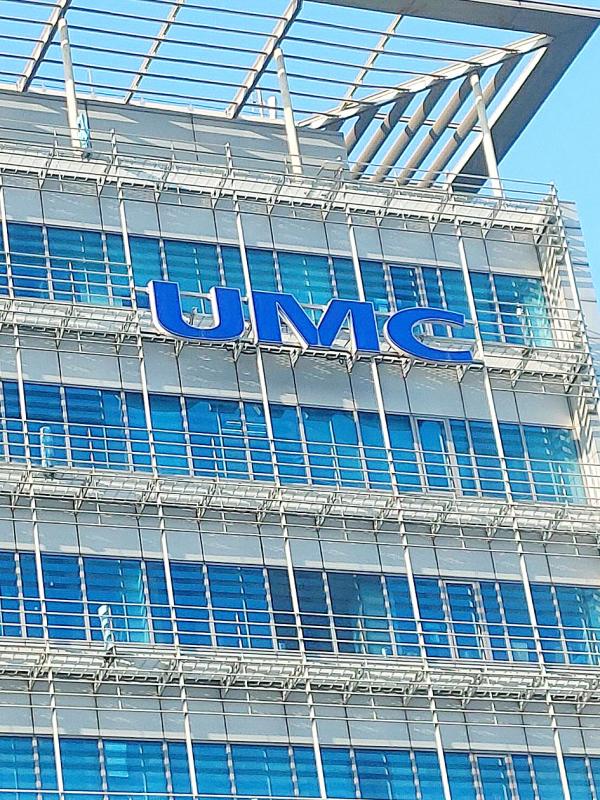United Microelectronics Corp (UMC, 聯電), the world’s third-largest contract chipmaker, saw its net profit grow almost 3-folds last quarter, thanks to robust chip demand for consumer electronics and computing-related applications.
Net profit surged to NT$11.2 billion (US$394.64 million) during the final quarter last year, compared with NT$3.84 billion in the same period of 2019. On a quarterly basis, net profit jumped 171 percent from NT$9.11 billion, UMC said yesterday.
For the full year of last year, net profit expanded 200 percent to NT$29.19 billion, from NT$9.71 billion. That translated into earnings per share of NT$2.42 last year, up from NT$0.82 in 2019.

Photo: Grace Hung, Taipei Times
Strong demand drove UMC’s factory utilization rate to 99 percent last quarter from 97 percent in the third quarter last year, the Hsinchu-based chipmaker told investors, adding that it expects the ratio to climb to 100 percent this quarter.
The firm can add a mere 3 percent more wafer capacity this year, primarily from 12-inch fabs, UMC copresident Jason Wang (王石) told a teleconference.
Demand for 8-inch wafers and some 12-inch wafers has outpaced capacity growth, Wang said.
The company said it expects 28-nanometer capacity to expand 20 percent this year, with revenue contribution climbing to about 25 percent from 14 percent last year.
UMC is open to new merger-and-acquisition opportunities to expand capacity, Wang said.
Asked about a shortage of auto chips, he said that UMC is “trying its best to mitigate the shortage.”
“We have been doing that since the beginning of this year,” he said. “Looking into the first quarter, stable demand will lead to an incremental increase in wafer shipments and blended average selling prices in US dollar terms.”
UMC said that it expects chip prices to increase by 2 to 3 percent from last quarter in US dollar terms, while wafer shipments are to grow at a quarterly pace of 2 percent.
As supply constraints are likely to last for the next few quarters, chip prices would rise by 4 to 6 percent this year, it said.
Gross margin would expand to 25 percent this quarter from 23.9 percent last quarter, on the back of price hikes, UMC said.
However, the appreciation of the New Taiwan dollar against the US dollar would offset more than half of the implied growth projected for the current quarter, Wang said.
UMC “continues to share the foundry industry’s positive view for wafer demand” for this year, Wang said, adding that the company plans to spend US$1.5 billion on new equipment this year, up 50 percent from US$1 billion last year.

Semiconductor business between Taiwan and the US is a “win-win” model for both sides given the high level of complementarity, the government said yesterday responding to tariff threats from US President Donald Trump. Home to the world’s largest contract chipmaker, Taiwan Semiconductor Manufacturing Co (TSMC, 台積電), Taiwan is a key link in the global technology supply chain for companies such as Apple Inc and Nvidia Corp. Trump said on Monday he plans to impose tariffs on imported chips, pharmaceuticals and steel in an effort to get the producers to make them in the US. “Taiwan and the US semiconductor and other technology industries

SMALL AND EFFICIENT: The Chinese AI app’s initial success has spurred worries in the US that its tech giants’ massive AI spending needs re-evaluation, a market strategist said Chinese artificial intelligence (AI) start-up DeepSeek’s (深度求索) eponymous AI assistant rocketed to the top of Apple Inc’s iPhone download charts, stirring doubts in Silicon Valley about the strength of the US’ technological dominance. The app’s underlying AI model is widely seen as competitive with OpenAI and Meta Platforms Inc’s latest. Its claim that it cost much less to train and develop triggered share moves across Asia’s supply chain. Chinese tech firms linked to DeepSeek, such as Iflytek Co (科大訊飛), surged yesterday, while chipmaking tool makers like Advantest Corp slumped on the potential threat to demand for Nvidia Corp’s AI accelerators. US stock

The US Federal Reserve is expected to announce a pause in rate cuts on Wednesday, as policymakers look to continue tackling inflation under close and vocal scrutiny from US President Donald Trump. The Fed cut its key lending rate by a full percentage point in the final four months of last year and indicated it would move more cautiously going forward amid an uptick in inflation away from its long-term target of 2 percent. “I think they will do nothing, and I think they should do nothing,” Federal Reserve Bank of St Louis former president Jim Bullard said. “I think the

SUBSIDIES: The nominee for commerce secretary indicated the Trump administration wants to put its stamp on the plan, but not unravel it entirely US President Donald Trump’s pick to lead the agency in charge of a US$52 billion semiconductor subsidy program declined to give it unqualified support, raising questions about the disbursement of funds to companies like Intel Corp and Taiwan Semiconductor Manufacturing Co (台積電). “I can’t say that I can honor something I haven’t read,” Howard Lutnick, Trump’s nominee for commerce secretary, said of the binding CHIPS and Science Act awards in a confirmation hearing on Wednesday. “To the extent monies have been disbursed, I would commit to rigorously enforcing documents that have been signed by those companies to make sure we get